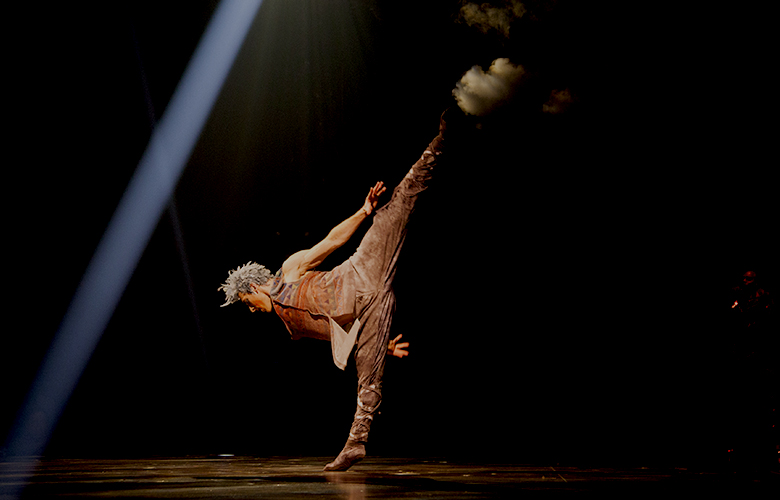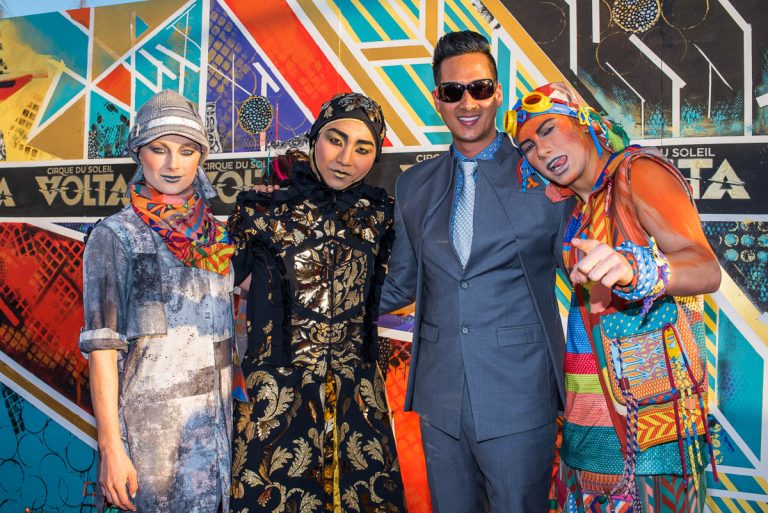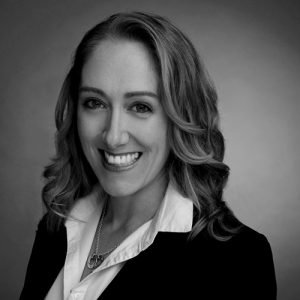
Cirque du Soleil’s latest touring show, VOLTA premiered on the 28th April, 2017 in Montreal. Johnny Kim, the Assistant Artistic Director of Operations shares with TheatreArtLife details on the transition process from VOLTA’s creation into the daily operations and what parts of the show he loves the most.
Johnny, what is your role on VOLTA and when did you join the team?
In this production, the role that I have is the Assistant Artistic Director of Operations. I joined in early March of this year.
What part of the creation process was VOLTA in when you joined?
I joined two days before the artists moved from the Cirque du Soleil Studios into the Big Top. The Cirque du Soleil International headquarters in Montreal are where all of the Creation training happens and the artists live onsite in what is called “The Residences”. The stage is all built up as it would be represented in the Big Top. When we move to the site everyone moves to the downtown area of Montreal closer to the Old Port where the show will be situated.
When the tent is raised, everything that they have been training on (sets, apparatus etc.) is inserted into the Big Top and I arrived 2 days prior to the artists arriving onsite. This was exciting because I got to see the site and get used to the set-up prior to the artist’s integration. I had a tour with Michael Smith (The Artistic Director of VOLTA) and we discussed a lot of things so I could get my bearings with the area. When the artists arrived onsite, that’s when we started staging in the big top as the show was still at the tail-end of creation mode.
The show was technically staged by the end of February with a full run-thru but the staging was still a continuation of that process with lighting, technical elements and artistic development. For the final 5 weeks prior to the opening, we were still creating and developing the show.
Was there a Production Artistic Director and a Production Assistant Artistic Director that were creating the show to be handed over to you for Operations? How does that work?
When I first arrived, it was a bit overwhelming as the production team involved a lot of people. There’s a Show Director and a Creation Director to help manage the vision and the people involved. There was a Character coach, Choreographer and numerous Acrobatic designers, Acrobatic choreographers and Concepteurs. We also had a Production Manager, Assistant Production Manager, Production Stage Manager, Technical Managers, Apparatus designers, Sound designers, Lighting designers, you name it, and we had it. Immersing the operations into the creation team was interesting because at first, you had to find out who was who, which was already a task in itself. You also have to know what everyone does and what their role is and then find out who is coming along on tour for the long haul as the show continues. Separating that, but knowing that we are all working together for the common goal, was an interesting process. Everyone was doing everything to make sure we had a great show to present to the world.
Are you in the operation phase now or is it still a cross-over? What has changed since the premiere last week?
We are actually still in the staging mode of the production as there are still changes to be made to make the show the best it can be. The production and creation team are still with us until May 5th, so it’s kind of a hybrid I would say. We are officially in operations because we have opened the show to the public, so we are now on a different daily schedule. At the same token, we are still at the service of the creation team to implement the amendments and elements of the show that need to be finished before they leave.
The major difference since the Premiere is that we are now in “Show Mode”. We can’t just have everyone work from 10 am to 10 pm as it is not feasible, for any department. The artists and technicians need rest. Everyone needs a break from constant change and we need to get back to basics. Acrobatic training needs to become more consistent so that we are making sure that we put out a great production on all levels. I would say that the biggest change in operations would be the schedule. We have to manage the workload across all departments as well as sustaining the health and safety of the artists who are getting into this mode of performing 8 shows a week.
The transition. The difference between creation and operation is that we, as operations now have to focus on making the show sustainable before we transcend the show artistically.
For myself and the Artistic Director, and the entire Artistic Department including Coaching and Stage Management, we have to take the vision with us and move forward by making it manageable by looking at the workload of the artists, the tracks, the back-ups for acts, and the understudies for the characters. You can imagine that in creation, directors will just pull who they see, and artists that would fit the role etc. but we need to also create a balance between it all.
Formulating the structure of tracks and show loads is very important. It must be reasonable to maintain the workload when we encounter 10 show weeks for weeks and months at a time. We have already started thinking about the integration of understudies and who will be able to back-up certain acts. We also have to cross train cues as with a cast of just under 50, there are a lot of cues to cover as our show is more like an ensemble. I myself am backing up a stage management track which is also new for me.
Being able to do a backstage track is really convenient because I can actually see what the artists do backstage, the ins and outs of their entire track, and not just what I see onstage. This is great because anything that they may come to me with, (issues etc.) I will have a full understanding of what it entails and I’m already starting to get my head wrapped around that. I think it is very beneficial for my job as a whole to have comprehensive knowledge of all that goes on both on and off stage.
 Photo by Patrice Lamoureux
Photo by Patrice LamoureuxHow long will you be with the show in Montreal and where will the tour go after that?
We are here till July 23rd in Montreal. Then the tour will take us across North America for the next year at least.
What’s your favorite part of the show thus far?
So this might be a long answer. First and foremost, my favorite part would be the message.
Waz, the main character, has blue hair and grew up being made fun of and laughed at because of it. Fighting adversity, he has pulled himself up to have this super elite celebrity status where is a host of an amazing TV show that everyone wants to take part in. He is not authentically himself and you can see that inner struggle in a scene with him backstage in his dressing room. I even think that there are celebrities in this day and age that also feel this way, where they have such high status but deep inside they potentially feel empty and alone.
Then Waz finds himself surrounded by uplifting people (we call them free spirits in the show) and you can tell that they are a positive impact on his life. They are free to be who they are and free to do what they are passionate about. Waz starts to see that he can learn to accept himself for who he is and do away with any insecurities, self- doubt or self-hatred. The reason why this message is so important is because it is so relatable. I think every one of us can empathise with what he is going through. We still live in an age where the world is still dealing with hate, racism and people being unaccepting of sexual orientation, social class, religion, etc. The list goes on and these are still issues we have today. People who feel like they are an outsider, an outcast, or different, will always feel some kind of insecurity as far as how they are going to be accepted in society. Anyone who comes to watch the show will be able to relate to this, to see the Waz in them, and hopefully, leave feeling liberated. Liberated to be themselves, be who they are, and go out in the world to be free to do whatever it is that makes them happy.
There are two specific moments in the show that complement this message that I love. We have a moment in the show called Daydreaming.
Waz takes out an old movie projector and watches a clip from when he was younger. You see a memory of him and his mother playing out in the fields where he is riding his bike. This transforms onto the stage where a ballet dancer represents the mother and a flatland artist is a younger version of Waz performing tricks on his bike. The young Waz feels insecure about being filmed because of his hair and she assures him that it is okay, to just have fun and to just be. As we watch them emulate the mother and son relationship we see the duality of her pirouettes and his bike spinning. With the swelling of the music and the pinnacle on the act, the end of it is a beautiful and powerful moment. You get so emotionally involved in the moment and that to me is what live theater is all about. That is why it is one of my favorites.
The second favorite thing I love about the show is the end when Waz finally finds his true freedom and takes a nice breath of air, deciding to be himself. He has this incredible dance solo at the end which is unorthodox because I believe that Cirque fans will expect the resolution to the story to be strictly acrobatic. When you follow his journey throughout the show and find the resolution with him, and then he starts this beautiful solo, it takes you inside. It’s a deep and impactful moment that leaves you with that emotional lump in your throat. It makes you feel.
Those two moments as far as story telling are important. And as the show is naturally a spectacle, we are also here to give a message and create a connection and a dialogue with the audience.
If you are able to sit there, watch the show and feel something, THAT is what I love about show business and those are the moments that shine for me the most. And of course, it doesn’t hurt to have incredible acrobatic acts that help complement the journey. The celebratory finale act with BMX is definitely something not to miss.
The tweaks that you are still doing now, if the flow and evolution of the story are still there, what’s still being worked on?
This week I don’t have an idea of what we are working on because we won’t find out until tomorrow. It’s probably decided as we speak and we will roll with the punches once that happens.
Is the team spending a couple of hours a day doing training and a couple of hours tweaking?
Yes, we have three days this week where we have allotted 2 hours per day for whatever the stagings will be and whatever the objectives the team wants to focus on. The creation team know that there are time constraints as we still need to provide adequate training time on stage for normal operations.
What are you doing in your downtime while you are in Montreal?
Well because everything has been so busy I haven’t had a lot of downtime but to be honest, since I am such a foodie, I am now trying to find amazing restaurants. As there are so many great places, I find myself reading yelp and google reviews and when I can, I go out into the city and get lost to find the little gems that this city has to offer. This also helps so I know where to take my mom when she comes this month.
When the group goes on tour, how big is the team that will go on the road?
There will be about 120 people who go on tour representing 23 different nationalities.
Thank you so much, Johnny, for giving us a look at behind the scenes of VOLTA and your experience within the show.
You’re welcome.
 Johnny Kim with some of the cast of VOLTA
Johnny Kim with some of the cast of VOLTAClick to see the Official Promo-roll


Anna Robb is Co-Founder and Managing Director for TheatreArtLife. Anna is an experienced Producer/Production Stage Manager. Her 20-year work history spans Asia Pacific, the Americas, Africa, the Middle East and Europe. She has worked for companies such as Cirque du Soleil, Franco Dragone Entertainment Group, Christie Digital Systems and The Sydney Opera House. Anna was an integral part of the research and development, training and formation, creation and operation of the 250 million dollar aquatic show, The House of Dancing Water in Macau. She also maintained the daily operations of this complex show as the head of Stage Management for 7 years. Anna has been employed on over 70 shows in the areas of concerts, arena events, corporate events, trade shows, musical theatre, plays, dance, circus, outdoor festivals and mega shows. Anna holds a honours degree in Design for Theatre and Television and is passionate about the evolution of the industry.
Read Full Profile© 2021 TheatreArtLife. All rights reserved.

Thank you so much for reading, but you have now reached your free article limit for this month.
Our contributors are currently writing more articles for you to enjoy.
To keep reading, all you have to do is become a subscriber and then you can read unlimited articles anytime.
Your investment will help us continue to ignite connections across the globe in live entertainment and build this community for industry professionals.